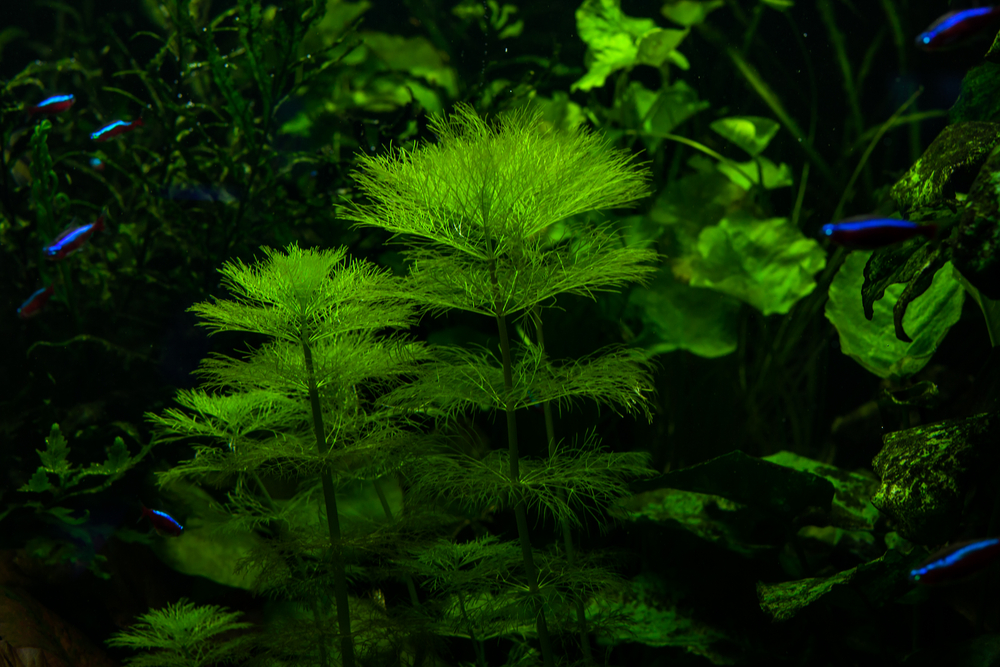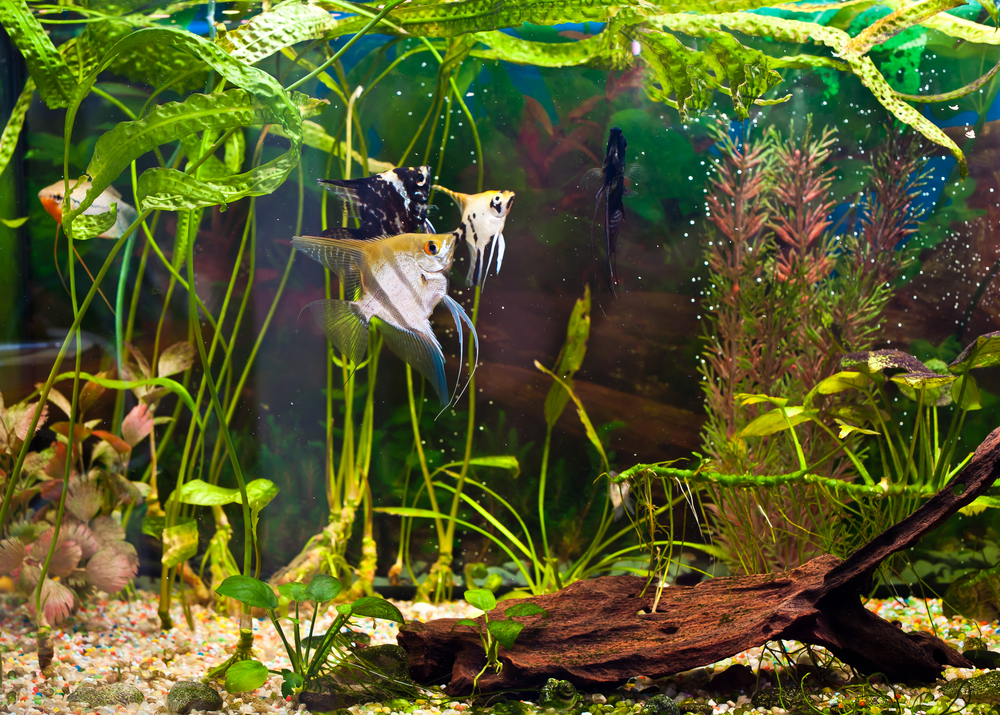An aquarium is more than just a place for fish to live. You can also keep plants in it! There are many different species of underwater and terrestrial plants that you can grow in an aquarium. Aquarium plants filter the water, provide shelter and food sources for small aquatic creatures, as well as make your tank look beautiful.
Types of Aquarium Plants
Underwater Plants
These aquarium plants typically grow in the roots and can be anchored to rocks or other objects in your tank. Underwater plants can grow so big that they will grow out of the tank. Keep them back with regular pruning.
Terrestrial Plants
Floating terrestrial plants are perfect for an aquarium because they don’t need any special care, but you should always make sure their leaves stay above water. The last thing you want to do is have them rot and smell up your tank.
Slow Growing Plants
These slow-growing plants are perfect for beginners because they only require occasional trimming, water changes, and fertilizer.
Fast Growing Plants
If you want something a little more active, then fast-growing plants might be the way to go. They’ll need traditional lightings as well as plenty of room to grow properly without being cramped by other plants or rocks.
Freshwater Plants
Some types of freshwater plants need to be submerged to grow correctly. Other types can live on top of the rocks and gravel, but they still require freshwater, so make sure you change it regularly, or else your fish will die.
Saltwater Plants
If you’re an expert with a salt-based tank, then these types of plants are probably for you. Usually, saltwater plants are more challenging than others when it comes to care and maintenance.
How to Care For Your Aquarium Plants
There are many ways to take care of your plants. When you first buy new ones, make sure they have enough space in the aquarium and are positioned well. Your aquarium will also have to be cleaned regularly so that your plants stay healthy. Finally, make sure you check that the plants you get are compatible with your fish. Here are some tips for how to take care of your aquatic plants:
Different Types of Aquarium Plant Care
Freshwater plants: These are usually easier to maintain because all you need is to monitor the algae growth on the plant and how big the plant is growing. You can help keep your plants healthy by cutting them back as they grow and fertilizing them. Saltwater plants: If you know anything about salt-based tanks, then you know it’s a bit more challenging to care for the plants. You’ll need a particular type of liquid fertilizer rather than regular tap water for saltwater plants.
Also, you should clean your aquarium’s filter regularly. Remember to remove any visible debris from the inside of the filter. Sealed aquariums may not need filters because they have such tight seals on their doors. But if you’re going this route, make sure to replace the air stones every few months since these will become clogged over time. Water changes are also an essential part of good care practices, so check your tank at least once per week for ammonia levels and pH balance before putting anything new into it.
Care Tips and Tricks for Your Aquarium Plants
Choose aquarium plants for your tank that will work with the amount of light, water flow, temperature, and other environmental conditions you have available to it. Each species has different needs, so explore them before deciding what’s best for your space.
Make sure you put enough plants in your tank – don’t overcrowd them or place too many together because they can use up all the oxygen from their surroundings which could be fatal to fish. The general rule is around one inch per gallon, but each type may vary slightly due to its individual requirements. Fish like plenty of plants to swim through and use as shelter, though, so research the plants you’re interested in before buying.
Pick the Right Light for Your Aquarium
If there is not enough light, the aquarium plant will become weak and unhealthy. Placing an aquarium plant in a shaded area without any supplemental lighting may cause it to wither and die. It looks like it’s giving up, but there are some things you can do that might help keep it alive such as moving it near a window where natural light shines through during the day—or even adding artificial lighting.
You can buy fluorescent tubes or compact fluorescent bulbs for extra brightness. Fluorescents work better than regular incandescent lights because their blue wavelengths promote photosynthesis, fueling plants’ growth (make sure your pet fish don’t get too close).
Fertilize and Prune Your Aquatic Plants
If your aquarium plants get too big for your current aquarium, you can transplant them into something larger. Just be sure not to leave any roots hanging as they’ll rot and cause the whole thing to die off—or at least stunt the growth of new ones.
Remember: leaves are food, so don’t fertilize plants when their leaves or stems have been cut back to promote rapid healing from a trimming session. Also, regularly inspecting your aquatic plants will keep pests like algae away. Algae can make your plants look less attractive and decrease their health because it blocks light exposure.
4 Cool Aquarium Plants We Love to See
Amazon Sword
Amazon sword is a common freshwater plant found in aquariums. The sword’s leaves are usually a light to medium green color with paler veins, and the plant has a thick stem that is typically brown or red.
The Amazon sword will grow best in an aquarium with plenty of space for it to spread out its roots and blades. It can be planted into any type of substrate but prefers sandy material because this allows more oxygen to reach the root system and provide better aeration when there’s water movement.
It does well under both high-light conditions (such as those created by spotlights) or low-light just so long as it gets regular fertilization on occasion. The amazon plant is the perfect background plant and can make your aquarium look like an underwater forest.
Marimo Moss Ball
Marimo moss balls are a green ball of algae that grows in freshwater aquariums. Marimo balls are not plants but rather colonies of the single-celled microalgae species, “Aegagropila linnaei.” Marimo moss balls can grow to be as large as two inches (a little over five centimeters). They float at or near the surface and form dense floating mats.
The marimo is an unusual plant because it does not require soil for growth. Instead, they absorb nutrients through their cell walls from water alone, making them perfect for placement into any type of aquarium without needing to worry about contaminating your tank with dirt or other debris.
To clean your marimo moss ball, take it out of your aquarium and rinse it off. To help your moss balls keep their shape, roll them in your hands. There are also algae-eating fish that will help keep your marimo moss balls clean.
Tiger Lotus
Tiger lotus is a common aquarium plant, but it is still one of the most interesting. There are two different kinds of leaf structures you can get. One type is a leaf that can be completely submerged, and the second type is a leaf that rests on the top of the water.
Some of the leaves are green with red accents, and other leaves are red with purple accents. To make your tiger lotus redder, give it medium to high light and an iron fertilizer. These lotus plants will need regular pruning to keep your other aquatic plants and fish healthy.
The tiger lotus will provide the perfect contrast to your other green plants. The lotus also can live in a wide variety of water temperatures. Iron-rich clay would be best for your tiger lotus, but it doesn’t require it.
Water Wisteria
Water wisteria is an easy plant to grow in your aquarium. They require little maintenance and are an easy plant to propagate. First, take a cutting and place it in water. The cutting will form roots over time. Once you have the roots, carefully plant them into your aquarium substrate, where they can grow freely.
Water wisteria is an excellent aquatic plant for beginner aquarists who don’t know how to take care of plants yet. Wisteria is excellent for your aquarium because it creates shelter for your fish and can help keep the water cleaner. The wisteria can be rooted in the substrate or lay over the substrate like a carpet.
The wisteria will happily grow without any extra help, so water changes and substrate cleaning is typically all you have to do. Both beginners and experts can have fun with water wisteria. Wisteria is a bright green color with large leaves. All water wisteria need is light to grow.
Okeanos Can Find You the Perfect Aquarium Plants
We hope this article has helped you learn more about the plants that can be used in your aquarium and give you some ideas for caring for them. If all of this sounds intimidating or you want help enacting these principles, let us know! Okeanos Aquascaping is waiting to partner with you on creating a beautiful aquatic space that reflects your style.
If you’ve been thinking about getting an aquarium for your home but don’t know where to start, we can help with that too. With our expert advice and consultation services, not only will you learn more about the best plants for your aquarium (or any other type of aquatic life), but we can also help pick out a design that is perfect for any space size. So to get started on designing your new underwater world today, call Okeanos Aquascaping at (212) 244-9555 or visit us online!










You must be logged in to post a comment.